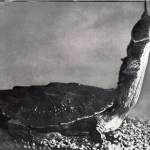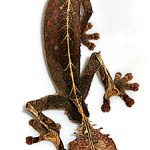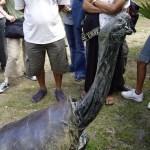herpetology
Some weeks ago I wrote a bit about the Matamata Chelus fimbriatus: a weird, flat-headed South American pleurodiran turtle. It's one of the strangest creatures tetrapods on the planet, and there's so much to say about it that the previous article ended up being nothing more than the briefest of introductions. Today we start looking at the Matamata in a bit more depth. We start with its affinities and its long neck...
Chelus is a chelid: that is, a member of the pleurodire turtle clade Chelidae. Despite - or perhaps because of - its bizarre appearance, the Matamata is sometimes regarded as…
Over the weekend my family and I visited Amazon World Zoo Park on the Isle of Wight. I saw tons of new stuff and had a great time, but what might have been my favourite creature is one that would have been all but ignored by the vast majority of visitors. I'm talking about the Matamata Chelus fimbriatus*, a bizarre South American river turtle that is as amazing in biology and behaviour as it is in appearance. Amazon World had two of them...
* The name is sometimes written (incorrectly) as Chelus fimbriata.
Matamatas are freakishly weird: they've even been referred to as "one of the…
In the previous few gekkotan articles we looked at the seriously weird and highly distinctive leaf-tailed geckos of Madagascar. There's another group of especially unusual, highly notable gekkonid gekkotans I want to write about: the flying, gliding or parachute geckos (Ptychozoon) of south-east Asia and India. These geckos are weird: the adjacent pic (widely available online, but only at frustratingly small size; it's credited to Tim Macmillan/John Downer) makes them look like tiny screaming dragons...
Parachute geckos are cryptic, forest-dwelling lizards. Patterned in greys or browns and…
I don't want to get into the habit of advertising TV shows, but in this case I can make a definite exception. Thanks to the people at Windfall for sending what's known in the business as a TX card. For the Tet Zoo articles on series 1, see...
Inside Nature's Giants: a major television event worthy of praise and accolade. Part I!
Inside Nature's Giants part II: whale guts and hindlimbs ahoy
Enough mammals for the time being: crocodiles on Inside Nature's Giants (part III)
Inside Nature's Giants part IV: the incredible anatomy of the giraffe
Time to press on once more with gekkotan lizards, and again with yet more on the remarkable leaf-tailed geckos (Uroplatus) of Madagascar. So far, we've been introduced to these lizards and have also looked at their anatomical pecularities and on a little bit of their history within the herpetological literature [image below shows U. phantasticus - I think - photographed at Mandatia; courtesy of Mary Blanchard].
But there's lots more to look at: at the recently named and soon-to-be-named species, at their phylogenetic position within Gekkota and, sadly, at their inevitable plight at human…
So, you've had an introduction to the incredible leaf-tailed geckos (Uroplatus). In view of their bizarre appearance, it's perhaps not so surprising that leaf-tailed geckos have commanded attention for a long time and there's a large historical literature on these animals (see Bauer & Russell (1989) for review) [U. fimbriatus shown here; image by J. W. Connelly, from wikipedia].
The very first description comes from Etienne de Flacourt's L'Histoire de la Grand Ãle de Madagascar, published in 1658, and some accounts from the early 1700s - referring to animals from Chile, Arabia and Egypt…
Before I start, allow me to announce that Tet Zoo merchandise is now available! So far, I've only used the Tet Zoo logo for these products, but I might produce additional designs in time.
Anyway... welcome to another article in the Tet Zoo gekkotan series. I really want to get through to the end without too many distractions (like amphiumas, wayward grey whales, manatees, white rhinos, giraffe-necked tortoises), otherwise I might never finish. Look what happened with toads and temnospondyls - so much work left to do! Anyway... by now, the generalities of gekkotan diversity, biology and…
A few days ago I visited my friends at the Centre for Fortean Zoology (for non-Tet Zoo-related reasons), and I particularly enjoyed looking at their amphiumas. Purely because I want to share the photos I took - well, and because amphiumas are weird, little known and really, really neat - I thought I'd say a little bit about them.
As usual, that 'little bit' quickly grew into a full-length article... nuts.
There really isn't much about amphiumas in the literature at all. They have been covered on Tet Zoo before: there's a brief introduction in one of the caudate articles (The wonder that…
Back to gekkotans: time to look at digits.
Geckos are well known for the ability of many species to cling to vertical surfaces, and even to ceilings. In fact, this is usually the one thing about geckos that everyone knows. The powers of gecko adhesion are such that geckos can support their entire weight while hanging from a single digit, they can remain stuck to leaves while exposed to 98 km/h winds, and they can also remain stuck to a surface when dead (Russell 1976). Expanded digital pads - called scansors or scansor pads - are lined on their undersides with rows of lamellae, and these…
Until recently the Mascarenes were home to an endemic radiation of giant tortoises, the Cylindraspis species. These were entirely separate from the better known, more 'typical' Mascarene giant tortoises grouped together in Dipsochelys or Aldabrachelys (Austin & Arnold 2001). Easily the most remarkable Cylindraspis tortoise was C. vosmaeri from Rodrigues, sometimes called the Rodrigues saddle-backed tortoise...
As you can see from these life-sized models, C. vosmaeri was a veritable giraffe (or sauropod) among tortoises: we have a good idea of its appearance in life thanks to a (very…
More on gekkotans, and this time were going to look at various details of gekkotan anatomy. Gekkotans are, being lizards, lizard-shaped (though with the near-limbless pygopodids being snake-like). But what makes them really special is that certain parts of their bodies - in particular, their hands and feet, and often their tails - are highly specialised and mightily weird [images here - from wikipedia - show the fat-tailed eublepharid Hemitheconyx caudicinctus and the gekkonine Ptychozoon kuhli with its tessellated tail].
We'll start by looking at tails. Many gekkotans use the tail for fat…
Now that the main gekkotan groups have been introduced, it's time to get down to some of the details. We begin with stuff on lifestyle and behaviour... [gekkotan motley below - mostly assembled from wikipedia - features (top, left to right) Aeluroscalabotes felinus, Pachydactylus bibronii, Rhacodactylus ciliatus and (bottom, left to right) Nephrurus amyae, Phyllodactylus xanti and Phelsuma madagascariensis].
Gekkotans are mostly insectivorous, but some of the large species prey on other lizards, and even on snails, birds, mammals (including bats) and small snakes. Nectar and pollen is eaten…
As you may know, Tet Zoo has been going for four years now. Despite this, there are still entire tetrapod clades - consisting of hundreds or even thousands of species - that have scarcely been mentioned here, if at all.
Lately, I've been feeling 'gecko guilt'. Yes, I can barely believe that the enormous squamate clade known as Gekkota has been all but unmentioned on these pages. I don't have time to give the group any sort of justice (sorry, Gekkota), but here is a very brief intro to the group and how neat it is (aaaaand, as usual I wrote this sentence long before completing what you're…
I was thrilled and delighted to encounter this amazing beast at a recent meeting. It's another of those creatures that you might know well from the literature, but (you assume) are unlikely to ever see in the flesh. Yet here it is...
Your challenge: tell us all what it is. As usual, this is dead easy... so long as you know the answer. And, to those people who have already seen the photos on my Facebook wall: you are not allowed to play.
It's a good time to feature neat lizards, what with today's publication of the paper on the new Philippine monitor Varanus bitatawa (Welton et al. 2010).…
tags: reptiles, chameleon species, herpetology, Chris Raxworthy, research, American Museum of Natural History, AMNH, New York City, field research, nature, travel, Madagascar, speciation, streaming video
With Madagascar containing nearly two-third's of the world's chameleon species, Christopher Raxworthy, Associate Curator of Herpetology at the American Museum of Natural History, recently embarked on an expedition to the island in search of these special lizards. His hope was to track down the lined-chameleon in order to further study speciation on Madagascar.
Having recently returned from…
I have to take a break. I may be gone for some time... I may not. Here are some cool photos.
If you're a long-time Tet Zoo reader you might remember the article about giant Asian softshell turtles from November 2007. That article - which mostly focused on the several Chitra species - was colourfully titled 'The goat-eating hot water bottle turtles'. As you may recall, the 'goat-eating' bit was inspired by a comment made in a turtle book (David Alderton's Turtles & Tortoises of the World): according to this source, Chitra 'may even attack goats, overturning them' (Alderton 1988, p. 165). That always seemed like a puzzling statement, but I decided to run with it. As kindly pointed…
Can you identify this South American snake? The photo comes courtesy of Paul Nicholas, who spotted the snake (which was about 1 m long) while it was crossing a river below the Great Falls and King George Falls in the (mostly unexplored) upper Essequibo region of Guyana. The strange-looking lumps are water drops. Paul's guides were not able to identify the snake - can you? I confess I haven't tried too hard... field guides on Guyanan snakes are thin on the ground round here...
But, with its enormous eye and parallel dorsal strikes, the animal (which is a 'colubrid') should be identifiable (if…
A stocky, medium-sized (up to 2 m long) and poorly known elapid with notably small eyes, Micropechis ikaheka - the Small-eyed or Ikaheka snake - is the only recognised member of its genus*. It's unique to New Guinea and some of the surrounding islands [adjacent image from Warrell et al. (1996)].
'Ikaheka' means 'land eel' in the local dialect and refers to the fact that it is sometimes associated with streams and other damp habitats. Micropechis is secretive, nocturnal or crepuscular and hunts for reptiles, frogs and mammals in cluttered rainforest and wetland habitats. It is regarded as…
South America has a diverse and well-studied toad fauna. The continent's toads include some decidedly untoad-like taxa, such as the brightly coloured stubfoot toads or harlequin frogs. These remarkable little animals are superficially similar to the better known poison-dart frogs. What makes South America's toads particularly interesting is that several of them occupy a basal position within bufonid phylogeny: in the phylogeny generated by Frost et al. (2006), Melanophryniscus, an Atelopus + Osornophryne clade, and Dendrophryniscus are all at the base of Bufonidae, while in Pramuk et al.'s (…


















